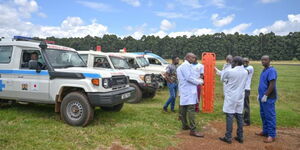The government plans to accelerate the addition of nuclear power to the national grid in a move that could result in the reduction of power costs across the country.
While speaking during the Sustainable Energy Conference on Wednesday, September 17, Energy Permanent Secretary Alex Wachira revealed that the government is moving to the second phase of nuclear development as it aims to have it on the power grid by 2034.
Wachira argued that by diversifying the energy sources, the average landing cost of power would go down. The average weighted cost of power refers to the overall cost of generating electricity from all sources, weighted by the proportion of each source in the energy mix.
This metric is crucial for understanding the economic implications of adding new energy sources like nuclear power. As such, a lower average weighted cost would then result in the cost of electricity bills going down.
PS Wachira revealed that the current average weighted cost in Kenya is 9.45 US cents. By adding nuclear, the government projected the cost to come down to four to 5.5 US cents. In other East African nations such as Ethiopia and Uganda, the cost averaged at six to 8.8 US cents.
The average weighted cost directly influences electricity tariffs, and as such, a lower cost will lead to decreased tariffs that consumers pay for.
Currently, Kenya's energy matrix is dominated by geothermal energy (40 per cent), with fossil fuels still making up 80 per cent of the energy sources. The cost of geothermal energy is relatively low compared to fossil fuels, but the addition of nuclear power, which has high initial and operational costs, could alter this balance.
The introduction of nuclear energy is reportedly set to cost Ksh367billion, making it the largest ever national project since the Standard Gauge Railway (SGR).
The construction of the 1,000 MW nuclear plant is set to begin in 2027 and begin operations by 2034. It is set to be located in Siaya.
However, the issue of who would be in charge of operations at the plant is still up in the air. Currently, Kenya’s energy laws stipulate that the Energy Cabinet Secretary must declare who will be the energy operator for the nuclear power plan to move to the next phase.
Wachira informed them that the options available would be to either pick an existing national energy generator or create a new body as the custodian for nuclear energy in the country.
Despite their low fuel costs, nuclear plants still have high operational and maintenance costs and require highly equipped personnel, safety protocols, and regular inspections.
It also requires a strong regulatory framework, with a great need to invest in training and capacity building to meet the international standards set by organisations like the International Atomic Energy Agency (IAEA).












